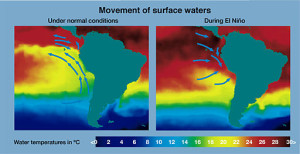El Niño Reaches Its Third Trimester
El Niño is wreaking chaos on the South Pacific Coast. On March 5, the United States’s National Ocean and Atmospheric Administration’s Climate Predication Center (CPC) released a report that concluded that the natural phenomenon known as El Niño has officially begun and that there is a 60 percent chance that it will develop into full force. The move surprised many climatologists, as El Niño typically occurs in mid-summer. Climate scientist Steve Zebiak noted, “I can’t think of a good analogue for this entire past 12 months over many decades”. The phenomenon’s odd behavior this year will strongly impact the South Pacific Coast’s economy and society. El Niño occurs when seawater warms and air patterns alter in strength. These conditions lead to drought-quenching rain among the nations that ring the Pacific. However, the CPC has indicated that current evidence suggests the impending El Niño, despite its potential to last for parts of the next two years, remains relatively weak and will bring little additional rainfall to North and Central America.
South America, however, has been experiencing drastically different conditions. Although it is too early to conclusively attribute recent weather shifts to El Niño, portions of Peru and Chile have faced unprecedented deluges over the past week.
In Atacama, Chile, the driest desert in the world, authorities were taken by surprise when nearby valleys flooded to the point of eliminating all accessibility except by helicopter. Runoffs caused by unseasonably warm weather combined with rain from some of the region’s heaviest storms in 80 years caused floods that have at least killed seven and injured 19. The Chilean government has taken efforts to reduce further threat to life by moving over 2,000 support personnel into the region and putting hundreds of affected citizens into shelters.
Other parts of Chile, however, are still in the grip of a drought that has haunted the country over the past seven years. Despite these conditions, the government remains optimistic that the current rainfall and impending El Niño could provide sufficient precipitation to ameliorate current water shortages, an outcome the country’s private sector desperately needs.
El Niño’s shadow extends past Chile and north into Peru, where extreme rainfall has caused widespread landslides, killing eight in the southwestern portion of the country. President Ollanta Humala imposed an emergency zone around the effected area, sending aid and relief workers to clear the roads and find missing persons. Non-governmental organizations (NGOs) like the Scout Association of Peru have also begun collecting non-perishable staples, clothing, and medicine to supplement government aid sent into the impacted zones.
Beyond the human costs, Peru and Chile are just beginning to account for the economic burdens imposed by the recent weather and prepare for El Niño’s effects. Peru also expects to find high economic costs as the warm waters pulled into the coast push anchovies deeper into the Pacific and beyond the range of fishermen’s nets. This exchange will depreciate fishmeal exports, depressing local economies.
Chile, the world’s largest copper producer, is in an even worse position. The flooding has closed roads and blocked access to copper deposits, choking off production and forcing the mines to shut down. Certain firms such as Canadian-owned Lundin Mining preemptively shut down mines, even those that were not closed due to inaccessibility. Chile’s drought-stricken southern regions have not fared better. Copper mines there have been shut down due to the lack of water available to complete the extraction process. To combat unpredictability, firms have started to consider creating desalinization plants in order to draw water from the ocean to power their plants.
South America’s western coast continues to prepare itself for an increasingly shocking meeting with El Niño. Given the sizable forewarning, Peru and Chile are considering harnessing the weather phenomenon to replenish their water-deprived reservoirs to combat droughts that have plagued the region for most of the past decade. With El Niño on their doorsteps, it is left to the individual countries to determine weather they will harness the benefits the storms will bring or let themselves be blown away.

